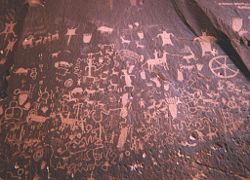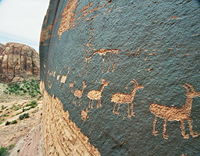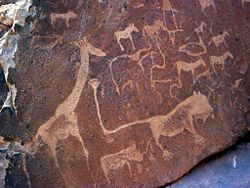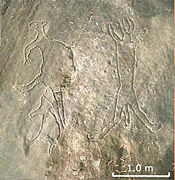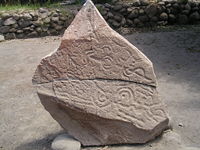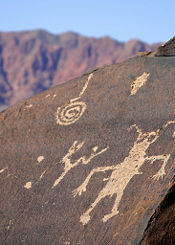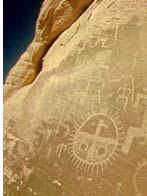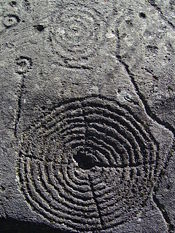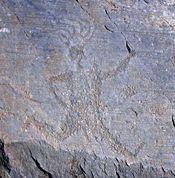Difference between revisions of "Petroglyph" - New World Encyclopedia
Nick Perez (talk | contribs) (→Africa) |
Rosie Tanabe (talk | contribs) |
||
| (43 intermediate revisions by 7 users not shown) | |||
| Line 1: | Line 1: | ||
| − | {{ | + | {{Images OK}}{{Submitted}}{{Approved}}{{Paid}}{{Copyedited}} |
[[Category:Politics and social sciences]] | [[Category:Politics and social sciences]] | ||
[[Category:Archaeology]] | [[Category:Archaeology]] | ||
[[Category:Art]] | [[Category:Art]] | ||
| + | [[Image:Newspaper rock.jpg|thumb|right|250px|Petroglyphs on Newspaper Rock State Historic Monument, southern Utah, USA]] | ||
| − | + | '''Petroglyphs''' are [[image]]s created by removing part of a [[Rock (geology)|rock]] surfaces by incising, pecking, carving, and abrading. Petroglyphs are found world-wide, and are often (but not always) associated with [[Prehistory|prehistoric]] peoples. They are one of the three different techniques used in [[Rock art]], the prehistoric precursors to [[art]]. The meaning of these works is still unclear, but much conjecture and speculation has been produced in academic circles. | |
| − | + | {{toc}} | |
| − | + | Some petroglyphs seem to depict real events whilst many other examples are apparently entirely abstract. Some theories hold that they may have been a way of transmitting information, while other theories ascribe them a [[religion|religious]] or ceremonial purpose. There are many common themes throughout the many different places that the petroglyphs have been found; implying the universality of purpose and similarity of the impulses that might have created the imagery. The phenomenon is thought by many to be the foundation of art as well as an indication of the development of [[cognition|cognitive]] and abstract ability in the evolution of humankind, as most was created before the advent of the first major [[civilization]]s. While we may not understand their purpose, we can appreciate and enjoy the [[beauty]] of petroglyphs, admiring the [[creativity]] of those from long-ago eras. | |
| − | + | [[Image:Libya 5321 Meercatze (Gatti Mammoni) Petroglyphs Wadi Methkandoush Luca Galuzzi 2007.jpg|thumb|right|250px|Rock carving known as "Meercatze" (named by archaeologist [[Leo Frobenius]]), rampant lionesses in Wadi Methkandoush, Mesak Settafet region of Libya.]] | |
| − | |||
| − | '''Petroglyphs''' are [[image]]s created by removing part of a [[Rock (geology)|rock]] surfaces by incising, pecking, carving, and abrading. Petroglyphs are found world-wide, and are often (but not always) associated with [[Prehistory|prehistoric]] peoples.They are one of the three different techniques used in [[Rock art]], the prehistoric precursors to [[art]]. The meaning of these works is still unclear, but much conjecture and speculation has been produced in academic circles. | ||
| − | |||
| − | The | ||
| − | |||
==History== | ==History== | ||
| − | + | {{readout||right|250px|Petroglyphs, or rock engravings, have been found dating back at least 10,000 years}} | |
| + | The word '''petroglyph''' comes from the [[Greek language|Greek]] words ''petros'' meaning "stone" and ''glyphein'' meaning "to carve" (it was originally coined in [[French language|French]] as ''pétroglyphe'').<ref>Douglas Harper, [http://dictionary.reference.com/browse/Petroglyph "Petroglyph"], ''Online Etymology Dictionary''. Retrieved December 11, 2007. </ref> | ||
| − | The oldest petroglyphs | + | The oldest petroglyphs are dated to approximately the [[Neolithic]] and late [[Upper Paleolithic]] boundary, about 10,000 to 12,000 years ago, if not earlier ([[Kamyana Mohyla]]).<ref>Albert B. Scholl, Jr., ''Rock Art and Ruins for Beginners and Old Guys'' (Rainbow Publishing Services, 2001).</ref> Around 7,000 to 9,000 years ago, other precursors of [[writing system]]s, such as [[pictograph]]s and [[ideogram]]s, began to appear. Petroglyphs were still common though, and some cultures continued using them much longer, even until contact with [[Western culture]] was made in the twentieth century. Petroglyphs have been found in all parts of the globe except [[Antarctica]] with highest concentrations in parts of [[Africa]], [[Scandinavia]], [[Siberia]], southwestern [[North America]], and [[Australia]]. |
==Technique== | ==Technique== | ||
| + | [[Image:Haljesta.jpg|thumb|right|200px|Composite image of petroglyphs from [[Scandinavia]] (Häljesta, Västmanland in Sweden). Nordic Bronze Age. The glyphs have been painted to make them more visible.]] | ||
| − | Petroglyphs are from removing rock in such ways as scratching, abrading, pecking, carving, drilling, incising and sculpting. Locations of choice are rock facets coated with patina, a dark mineral accumulation on rock surfaces. Petroglyphs remove the patina, exposing the contrasting lighter rock interior. Instances of negative images, produced by removing the patina surrounding the intended figure, are also known. Sometimes petroglyphs are painted or accentuated by polishing. The degree of repatination indicates relative dating. Some of the most ancient petroglyphs are the same color as the surrounding rock. | + | Petroglyphs are from removing rock in such ways as scratching, abrading, pecking, carving, drilling, incising, and sculpting. Locations of choice are rock facets coated with [[patina]], a dark mineral accumulation on rock surfaces. Petroglyphs remove the patina, exposing the contrasting lighter rock interior. Instances of negative images, produced by removing the patina surrounding the intended figure, are also known. Sometimes petroglyphs are painted or accentuated by polishing. The degree of repatination indicates relative dating. Some of the most ancient petroglyphs are the same color as the surrounding rock. |
==Interpretation== | ==Interpretation== | ||
[[Image:MtnSheepPetroglyph.jpg|thumb|left|200px|A petroglyph of a caravan of [[bighorn sheep]] near [[Moab, Utah]], [[USA]]; a common theme in glyphs from the [[desert]] southwest]] | [[Image:MtnSheepPetroglyph.jpg|thumb|left|200px|A petroglyph of a caravan of [[bighorn sheep]] near [[Moab, Utah]], [[USA]]; a common theme in glyphs from the [[desert]] southwest]] | ||
| − | There are many theories to explain their purpose, depending on their location, age, and the type of image. | + | There are many theories to explain their purpose, depending on their location, age, and the type of image. Some petroglyphs are thought to be astronomical markers, maps, and other forms of symbolic communication, including a form of "pre-[[writing]]." They might also have been a by-product of other rituals: sites in [[India]], for example, have been identified as [[musical instrument]]s or "rock gongs." <ref>[http://news.bbc.co.uk/2/hi/science/nature/3520384.stm Ancient Indians made 'rock music'], BBC News Friday, 19 March, 2004. Retrieved December 19, 2007.</ref> |
| − | Some petroglyph images probably had deep cultural and religious significance for the societies that created them; in many cases this significance remains for their descendants. Many petroglyphs are thought to represent some kind of not-yet-fully understood symbolic or ritual language. Later glyphs from the [[Nordic Bronze Age]] in Scandinavia seem to refer to some form of territorial boundary between [[tribe]]s, in addition to possible religious meanings. It also appears that local or regional | + | Some petroglyph images probably had deep cultural and religious significance for the societies that created them; in many cases this significance remains for their descendants. Many petroglyphs are thought to represent some kind of not-yet-fully understood symbolic or ritual language. Later glyphs from the [[Nordic Bronze Age]] in [[Scandinavia]] seem to refer to some form of territorial boundary between [[tribe]]s, in addition to possible religious meanings. It also appears that local or regional [[dialect]]s from similar or neighboring peoples exist. The [[Siberia]]n inscriptions almost look like some early form of [[Runic alphabet|runes]], although there is not thought to be any relationship between them. They are not yet well understood. |
| − | Some researchers have noticed the resemblance of different styles of petroglyphs across different continents; while it is expected that all people would be inspired by their surroundings, it is harder to explain the common styles. This could be mere coincidence, an indication that certain groups of people [[Human migration|migrated]] widely from some initial common area, or indication of a common origin.<ref>Beckensall, | + | Some researchers have noticed the resemblance of different styles of petroglyphs across different continents; while it is expected that all people would be inspired by their surroundings, it is harder to explain the common styles. This could be mere coincidence, an indication that certain groups of people [[Human migration|migrated]] widely from some initial common area, or indication of a common origin.<ref>Stan Beckensall, ''Northumberlands Prehistoric Rock Carvings: Mystery Explained'', (Pendulum Press 1983 ISBN 0950693537)</ref> Other theories suggest that petroglyphs were made by [[shaman]]s in an [[altered state of consciousness]]<ref>Ekaterina Devlet, [http://scandinavian.wisc.edu/dubois/Courses_folder/shamanism_readings/2_9_13/Devlet.pdf Rock Art and the Material Culture of Siberian and Central Asian Shamanism] in ''The Archaeology of Shamanism'', ed. Neil Price 43-55 (London: Routledge, 2001). Retrieved December 19, 2007. </ref>, perhaps induced by the use of natural [[hallucinogen]]s. Many of the [[Geometry|geometric]] [[pattern]]s (known as [[form constant]]s) which recur in petroglyphs and [[cave painting]]s have been shown to be "hard-wired" into the human brain; they frequently occur in visual disturbances and [[hallucination]]s brought on by drugs, [[migraine]], and other stimuli. |
| − | == | + | ==Petroglyph sites== |
===Africa=== | ===Africa=== | ||
| − | [[Image:Lion Twyfelfontein Namibia.JPG|thumb|250px|Lion Petroglyph, Twyfelfontein, Namibia]] | + | [[Image:Lion Twyfelfontein Namibia.JPG|thumb|left|250px|Lion Petroglyph, Twyfelfontein, Namibia]] |
| − | There are many famous sights of petroglyph works in [[Africa]]. [[Tassili n'Ajjer]] in [[Algeria]] is noted for its [[prehistoric]] [[rock painting]]s and other ancient [[archaeology|archaeological]] sites, dating from [[neolithic]] times when the local climate was much moister, with [[Savanna|savannah]] rather than desert. The art depicts herds of cattle, large wild animals including | + | There are many famous sights of petroglyph works in [[Africa]]. [[Tassili n'Ajjer]] in [[Algeria]] is noted for its [[prehistory|prehistoric]] [[rock painting]]s and other ancient [[archaeology|archaeological]] sites, dating from [[neolithic]] times when the local climate was much moister, with [[Savanna|savannah]] rather than [[desert]]. The art depicts herds of [[cattle]], large wild animals including [[crocodile]]s, and human activities such as [[hunting]] and [[dancing]]. The art has strong stylistic links to the pre-Nguni [[Art of South Africa]] and the region, executed in caves by the [[San]] Peoples before the year 1200 C.E. |
| − | [[Akakus]], [[Libya]] was inscribed as a [[UNESCO]] [[World Heritage Site]] in | + | [[Akakus]], [[Libya]] was inscribed as a [[UNESCO]] [[World Heritage Site]] in 1985 because of the importance of its rock paintings and carvings. The art dates from 12,000 B.C.E. to 100 C.E. and reflect [[culture|cultural]] and [[nature|natural]] changes in the area.<ref>UNESCO World Heritage Centre [http://whc.unesco.org/en/list/287"Rock-Art Sites of Tadrart Acacus"] Retrieved December 13, 2007.</ref> There are paintings and carvings of animals such as [[giraffe]]s, [[elephant]]s, [[ostrich]]es, and [[camel]]s, but also of men and [[horse]]s. Men are depicted in various daily life situations, for example while making music and dancing. |
| − | The ancient city of [[Wadi Hammamat]] in [[Qift]], [[Egypt]] has many carvings and inscriptions dating from before the earliest Egyptian Dynasties to the modern era, including the only painted petroglyph known from the Eastern Desert and drawings of Egyptian reed boats dated to 4000 B.C.E. | + | The ancient city of [[Wadi Hammamat]] in [[Qift]], [[Egypt]] has many carvings and inscriptions dating from before the earliest [[ancient Egypt|Egyptian Dynasties]] to the modern era, including the only painted petroglyph known from the Eastern Desert and drawings of Egyptian reed boats dated to 4000 B.C.E. |
| − | Other important sites in Africa include Bidzar in [[Cameroon]], Bambari, Lengo and Bangassou in the south of the [[Central African Republic]]; Bwale in the west, [[Niola Doa]] in [[Chad]], the Niari River valley in the [[Republic of the Congo|Congo]], Ogooue River Valley in [[Gabon]], [[Jebel Uweinat]] in [[Libya]], the [[Draa River]] valley in [[Morocco]], the Twyfelfontein in [[Namibia]], and | + | Other important sites in Africa include Bidzar in [[Cameroon]], Bambari, Lengo, and Bangassou in the south of the [[Central African Republic]]; Bwale in the west, [[Niola Doa]] in [[Chad]], the Niari River valley in the [[Republic of the Congo|Congo]], Ogooue River Valley in [[Gabon]], [[Jebel Uweinat]] in [[Libya]], the [[Draa River]] valley in [[Morocco]], the Twyfelfontein in [[Namibia]], and life-size [[giraffe]] carvings on Dabous Rock, Air Mountains, in [[Niger]]. |
| − | life-size [[giraffe]] carvings on Dabous Rock, Air Mountains, in [[Niger]]. | ||
===Australia=== | ===Australia=== | ||
| − | [[Image:Terrey Hills public.jpg|thumb|175px| | + | [[Image:Terrey Hills public.jpg|thumb|175px|right|Engravings at Terrey Hills, near Sydney, NSW. The two kangaroos suggest this was used for an increase ceremony, whilst the well-endowed man may be [[Baiame]].]] |
| − | [[Murujuga]], in [[Western Australia]] is a unique ecological and archaeological area since it contains the world's largest and most important collection of | + | [[Murujuga]], in [[Western Australia]] is a unique ecological and archaeological area since it contains the world's largest and most important collection of petroglyphs – ancient [[Aborigines|Aboriginal]] rock carvings some claim to date back as far as the last [[ice age]]. The collection of [[standing stone]]s is the largest in Australia. The [[rock art]] numbers over a million petroglyphs and contains many images of the now [[extinct]] [[Thylacine]] (Tasmanian Tiger). |
| − | The [[Sydney Rock Engravings]] | + | The [[Sydney Rock Engravings]] consist of carefully drawn images of people, animals, and symbols, in the [[sandstone]] around [[Sydney]], [[New South Wales]], Australia. Many thousands of such [[engraving]]s are known to exist in the Sydney region, although the locations of most are not publicized in order to prevent damage by [[vandalism]], and to retain their sanctity, as they are still regarded as sacred sites by Indigenous Australians. They are comparable to petroglyphs of [[Indigenous peoples of the Americas|Native Americans]], yet have their own distinctive style which is unlike rock art found anywhere else in Australia. |
There is also a famous petroglyph site at [[Arnhem Land]] / [[Kakadu National Park]], in Northern Australia. | There is also a famous petroglyph site at [[Arnhem Land]] / [[Kakadu National Park]], in Northern Australia. | ||
===Asia=== | ===Asia=== | ||
| − | [[Image:Cheung Chau Rock Carving 1.jpg|thumb| | + | [[Image:Cheung Chau Rock Carving 1.jpg|thumb|200px|left|Rock carving on [[Cheung Chau]] Island, [[Hong Kong]]. This 3000-year-old rock carving was reported by [[geologist]]s in 1970]] |
| − | The diversity of Asia's geography and culture is mirrored in its quantity of petroglyphs. Hong Kong | + | The diversity of Asia's geography and culture is mirrored in its quantity of petroglyphs. [[Hong Kong]] alone has eight significant sites: [[Tung Lung Island]], [[Kau Sai Chau]], [[Po Toi|Po Toi Island]], [[Cheung Chau]], [[Shek Pik]] on Lantau Island, [[Wong Chuk Hang]] and [[Big Wave Bay]] on [[Hong Kong Island]], and [[Lung Ha Wan]] in [[Sai Kung]] |
| − | The [[Edakkal Caves]] | + | The [[Edakkal Caves]] in Wayanad, Kerala, in [[India]] date back to about 4000 B.C.E. These are not technically caves by rather a [[cleft]] or [[rift]] approximately 96 feet by 22 feet, a 30 foot deep [[fissure]] caused by a piece of rock splitting away from the main body. On one side of the cleft a rock weighing several tons has fallen over the fissure forming a roof. The carvings are of human and animal figures, as well as of tools used by humans and symbols, suggesting they were created by a highly civilized prehistoric people.<ref name=kerala> Kerala.gov "Places of Tourist Importance" 2007. </ref> The petroglyphs inside the cave are of at least three distinct types. The oldest may date back over 5000 years ago. Evidence indicates that the Edakkal caves had been inhabited at several different times in history.<ref name=kerala/> |
| − | |||
| − | |||
| − | |||
| − | |||
| − | |||
| − | The | ||
| − | The oldest may date back over 5000 years ago. Evidence indicates that the Edakkal caves had been inhabited at several different times in history.<ref | ||
| − | |||
| − | |||
| − | |||
| − | |||
| − | |||
| − | The [[Bangudae Petroglyphs]], in Korea are located in Daegok-ri, [[Ulsan]], [[South Korea]]. | + | The [[Bangudae Petroglyphs]], in Korea are located in Daegok-ri, [[Ulsan]], [[South Korea]]. This site of substantial engraved rock art was rediscovered in 1971 and was designated as the 285th [[National treasures of South Korea|National Treasure of South Korea]] on June 23, 1995. The petroglyphs sit in an isolated forested area almost completely enclosed by steep mountains adjacent to the Daegok-cheon River, a tributary of the Taehwa River. There are three major panels in an area measuring 3 m in height and 10 m in length. A number of panels with similar rock-art motifs have been found nearby at the Cheonjeon-ni site. |
| − | It is commonly thought that the | + | It is commonly thought that the petroglyphs (Kr. ''amgakhwa'' or ''bawi geurim,'' 바위그림) at this site depict the physical embodiment of the hopes and wishes of prehistoric people. In this case, the petroglyphs were made to wish for a successful hunt or an abundance of prey. |
| − | Other important sites include | + | Other important sites include [[Chumysh (river)|Chumysh River]] basin, in Khaszikstan, the [[Tamgaly]] on the [[Ili River]], a [[World Heritage Site]], the [[Yin Mountains]] in [[Inner Mongolia]], the Rock art and petroglyphs in Northern Areas in [[Pakistan]], and the [[Angono Petroglyphs]] of [[Rizal]] in the [[Philippines]]. |
===South America=== | ===South America=== | ||
| − | [[Image:PetroglyphAzapa1.jpg|thumb| | + | [[Image:PetroglyphAzapa1.jpg|thumb|right|200px|A petroglyph from the Azapa valley, exhibited in front of the museum in San Miguel de Azapa, 12 km east of Arica, Chile]] |
| − | There are two famous sites of petroglyphs in [[South America]]. [[Cumbe Mayo]] in [[Peru]] is the site of ruins of a Pre-Columbian aqueduct stretching approximately five miles in length. There are a number of | + | There are two famous sites of petroglyphs in [[South America]]. [[Cumbe Mayo]] in [[Peru]] is the site of the ruins of a Pre-Columbian [[aqueduct]] stretching approximately five miles in length. There are a number of petroglyphs on the aqueduct and surrounding caverns. |
| − | The [[Corantijn Basin]] | + | The [[Corantijn Basin]], one of a number of archaeological sites in [[Suriname]], contains a large number of petroglyphs. An interesting aspect of these petroglyphs is that they are all found near water. Unfortunately, though, the majority of these petroglyphs cannot be connected to specific prehistoric indigenous groups.<ref> A.H. Versteeg, [http://home.planet.nl/~vrstg/guianas/suriname/rgdpaper.htm "The history of archaeological research in Suriname."] Retrieved July 28, 2011.</ref> |
===North America=== | ===North America=== | ||
| + | [[Image:Pictograph tds.jpg|thumb|right|175px|Native American Pictograph near Saint George, Utah USA]] | ||
| + | North America has more petroglyph sites than any other continent. A large cluster is located in the Southwestern [[United States]], and are protected by National Park boundaries, such as [[Arches National Park]] and [[Capitol Reef National Park]] of [[Utah]], [[Death Valley National Park]], [[Lava Beds National Monument]], [[Tule Lake, California|Tule Lake]], [[Maturango Canyon]], and [[Coso Range, Northern Mojave]] in [[California]]. There are also sites in [[Arkansas]], [[Washington]], [[Michigan]], and [[Ohio]]. | ||
| + | [[Image:Petroglyphs in Bryce Canyon.jpg|thumb|left|175px|Petroglyphs in Bryce Canyon National Park]] | ||
| + | The [[Jeffers Petroglyphs]] site is an outcrop of rock in southwestern [[Minnesota]] with pre-contact [[Native Americans in the United States|Native American]] petroglyphs. The petroglyphs are pecked into rock of the Red Rock Ridge, a {{convert|23|mi|km|0|sing=on}}-long [[quartzite|Sioux quartzite]] outcrop that extends from [[Watonwan County, Minnesota]] to [[Brown County, Minnesota]]. The exposed surface is approximately {{convert|150|ft|m|-1}} by {{convert|650|ft|m|-1}} and surrounded by virgin prairie. Several old wagon trail ruts traverse the site, one of which is believed to be the old stage coach route from [[New Ulm, Minnesota]] to [[Sioux Falls, South Dakota]].<ref> Cottonwood County Historical Society, ''Centennial History of Cottonwood County, Minnesota.'' (Cottonwood County Historical Society, 1970).</ref> | ||
| − | + | Petroglyph National Monument stretches 17 miles (27 km) along [[Albuquerque, New Mexico]]'s West Mesa, a [[volcano|volcanic]] [[basalt]] [[escarpment]] that dominates the city’s western horizon. The 7,236 [[acre]] (29.28 km²) monument is cooperatively managed by the [[National Park Service]] and the City of Albuquerque. Petroglyph National Monument protects a variety of cultural and natural resources including five [[volcanic cones]], hundreds of archaeological sites and an estimated 25,000 images carved by native peoples and early Spanish settlers. Many of the images are recognizable as animals, people, [[Livestock branding|brands]] and crosses; others are more complex. Their meaning was, possibly, understood only by the carver. These images are the cultural heritage of a people who have long since moved into other areas and moved on through history. The monument protects them for visitors to see and appreciate for generations to come. | |
| − | |||
| − | [[ | ||
| − | [[Petroglyph | + | There are over 21,000 petroglyphs at the [[Three Rivers Petroglyph Site]] in Three Rivers, [[New Mexico]], located midway between [[Tularosa, New Mexico|Tularosa]] and [[Carrizozo, New Mexico|Carrizozo]] in [[Otero County, New Mexico|Otero County]].<ref>Jim Reed, [http://www.southernnewmexico.com/Articles/Southeast/Otero/ThreeRiversPetroglyphssit.html Three Rivers Petroglyphs Site—21,000 Carvings] SouthernNewMexico.com. Wednesday, July 16, 2003. Retrieved December 13, 2007.</ref> Many of the petroglyphs can be easily viewed from a trail open to the public which winds through the rocks for about one mile. The petroglyphs are thought to be the product of the [[Mogollon culture|Jornada Mogollon]] people between about 1000 and 1400 C.E. The site is protected and maintained by the [[Bureau of Land Management]]. The exact age of the petroglyphs is not known, but some [[atlatl]] symbols at Jeffers are a close match with similar symbols at [[Indian Knoll]] in [[Kentucky]], which have been dated to 3000 B.C.E. These are probably the earliest petroglyphs at the site and indicate that the site was first visited during the [[Late Archaic Period]]. Another clue to the age comes from the projectile point carvings, which show a projectile point design used by hunters in the Late Archaic Period. Other carvings, such as [[thunderbird (mythology)|thunderbirds]], [[dragonfly|dragonflies]], [[turtle]]s, and [[shaman]]s, are symbolic of later tribes such as the [[Otoe tribe]], [[Sioux]], and [[Iowa tribe]]. These are believed to date between 900 C.E. and 1750 C.E.. |
| − | [[ | ||
| − | |||
| − | [http://www.southernnewmexico.com/Articles/Southeast/Otero/ThreeRiversPetroglyphssit.html | ||
| − | </ref> | ||
| − | |||
| − | + | There are several sites in [[Canada]], in [[British Columbia]], [[Ontario]] and [[Nova Scotia]]. [[Petroglyphs Provincial Park]], is situated northeast of [[Peterborough, Ontario|Peterborough]], Ontario, Canada. It has the largest collection of ancient [[First Nations]] petroglyphs in Ontario. The carvings were created in the [[pre-Columbian]] era and represents aspects of First Nations mysticism, including shamans, animals, and the [[Great Spirit]]. The sacred stone is generally believed to have been carved by the [[Algonquin|Algonkian people]] between 900 and 1400 C.E. Today, the First Nations people of Ontario call the carvings ''Kinomagewapkong'', meaning "the rocks that teach" or "the Teaching Rocks." | |
| − | |||
| − | |||
| − | |||
| − | |||
| − | |||
| − | There are several sites in [[Canada]], in [[British Columbia]], [[Ontario]] and [[Nova Scotia]]. [[Petroglyphs Provincial Park]], | ||
There are also petroglyph sites at Mina, [[Nuevo Leon]] in [[Mexico]]. | There are also petroglyph sites at Mina, [[Nuevo Leon]] in [[Mexico]]. | ||
===Europe=== | ===Europe=== | ||
| + | [[Image:Carschenna 04.jpg|thumb|right|175px|Concentric circles with a cross. Rock carvings of Carschenna in Switzerland, abt 3500 yrs old.]] | ||
| + | Like North America, [[Europe]] hosts a number of petroglyph sites. [[Mercantour National Park]] in [[France]], [[Newgrange]] in [[Ireland]], the [[Vale do Côa rock carvings]] of [[Portugal]], the [[Tanumshede]] ([[Bohuslän]]) of [[Sweden]] (which is also a World Heritage Site) and [[Kamyana Mohyla]] in the [[Ukraine]] all have petroglyph sites. | ||
| − | + | The [[Cup and ring mark]]ed rocks in [[Northumberland]], [[England]] are unique among petroglyphs. They consist of a concave depression, no more than a few centimeters across, pecked into a rock surface and often surrounded by concentric circles also etched into the stone. Sometimes a linear channel called a gutter leads out from the middle. Where they are etched onto natural, flat stone it has been observed that they seem to incorporate the natural surface of the rock. Those at Hunterheugh are mostly connected to one another by gutters that can channel rainwater from one to the next, down the sloping top of the stone. | |
| + | [[Image:Arte Rupestre Valcamonica Sacerdote.jpg|left|thumb|175px| Cammune rock engraving in Valcamonica]] | ||
| + | The site of [[Val Camonica]], [[Italy]] is home to the greatest complex of rock drawings in sub-Alpine Italy, with approximately 350,000 petroglyphs drawn by members of the [[Camunni]] tribe on hundreds of exposed rocks dating from about 8000 B.C.E.; cosmological, figurative, and cartographic motifs are featured, in some locations forming monumental hunting and ritual "scenes." | ||
| + | It includes also scenes of [[Historical and cultural perspectives on zoophilia|zoophilia]]. | ||
| − | + | The [[Rock carvings at Alta]] in [[Norway]] are located now at a World Heritage Site. Since the first petroglyphs were discovered in 1972, more than 5000 carvings have been found on several sites around Alta. The main site, located at [[Jiepmaluokta]] about 4 kilometers outside of Alta, contains around 3000 individual carvings and has been turned into an open-air [[museum]]. It is Norway's only [[prehistory|prehistoric]] World Heritage Site. The earliest carvings in the area date to around 4200 B.C.E.; the most recent carvings are generally dated to around 500 B.C.E. The wide variety of imagery shows a [[culture]] of [[hunter-gatherer]]s that was able to control [[herd]]s of [[reindeer]], was adept at boat building and [[fishing]] and practiced [[shamanism|shamanistic]] [[ritual]]s involving [[bear worship]] and other venerated [[animal]]s. Apart from the visual evidence of the carvings themselves, not much is known about the culture that produced these carvings. | |
| − | + | ===Middle East=== | |
| − | + | There are petroglyph sites in the [[Wadi Rum]] and [[Wadi Faynan]] of [[Jordan]], made by many human cultures since prehistoric times, with many cultures—including the [[Nabatean]]s—all of whom left their mark in the form of rock paintings, [[graffiti]], and temples. The "Graffiti Rocks," about 110 km SW of [[Riyadh]] off the [[Mecca]] highway is another important petroglyph site in the Middle East. | |
| − | |||
| − | + | ==Notes== | |
| − | |||
| − | |||
| − | |||
| − | |||
| − | + | <references/> | |
| − | + | ==References== | |
| − | |||
| − | * | + | *Beckensall, Stan. ''Prehistoric Rock Art in Northumberland.'' Tempus Publishing, 2001. ISBN 0752419455 |
| − | + | *Beckensall, Stan, and Tim Laurie. ''Prehistoric Rock Art of County Durham, Swaledale and Wensleydale.'' County Durham Books, 1998. ISBN 1897585454 | |
| − | * | + | *Cottonwood County Historical Society. ''Centennial History of Cottonwood County, Minnesota''. Cottonwood County Historical Society, 1970. {{ASIN|B000LPUQ9Y}} |
| − | * | + | *de Jonge, R.M., and J.S. Wakefield. [http://www.slideshare.net/rmdejonge/lousumm-2-8458972 Discovery of the Islands in the Ocean], 2011. Retrieved July 2, 2011. |
| − | * [ | + | *Keyser, James D. ''Indian Rock Art of the Columbia Plateau.'' University of Washington Press, 1992. ISBN 978-0295971605 |
| − | * | + | *Morris, Ronald. ''The Prehistoric Rock Art of Galloway and The Isle of Man.'' Blandford Press 1979. ISBN 978-0713709742 |
| − | * | + | *Price, Neil. ''The Archaeology of Shamanism.'' London: Routledge, 2001. ISBN 978-0415252553 |
| − | * | + | *Scholl, Albert B., Jr. ''Rock Art and Ruins for Beginners and Old Guys.'' Rainbow Publishing Services, 2001. ISBN 0970468806 |
| − | * | + | *Versteeg, A.H. [http://home.planet.nl/~vrstg/guianas/suriname/rgdpaper.htm "The history of archaeological research in Suriname."] In Th.E. Wong, D.R. de Vletter, L. Krook, J.I.S. Zonneveld, and A.J. van Loon (eds.), ''The History of Earth Sciences in Suriname'' (Kon. Ned. Academie Wetenschappen & Nederlands Instituut voor Toegepaste Geowetenschappen TNO, (1998): 203-234). Retrieved July 28, 2011. |
| − | * [ | ||
| − | |||
| − | |||
| − | |||
| − | |||
| − | |||
| − | |||
| − | |||
| − | |||
==Gallery== | ==Gallery== | ||
| Line 162: | Line 128: | ||
Image:Hawaii petroglyph men.jpg|[[Hawaii Volcanoes National Park]] | Image:Hawaii petroglyph men.jpg|[[Hawaii Volcanoes National Park]] | ||
Image:Motu Nui.jpg|Petroglyphs at [[Orongo]], [[Rapa Nui]] (Easter Island). A [[Make-make]] at the base and two [[Tangata Manu|birdmen]] higher up | Image:Motu Nui.jpg|Petroglyphs at [[Orongo]], [[Rapa Nui]] (Easter Island). A [[Make-make]] at the base and two [[Tangata Manu|birdmen]] higher up | ||
| + | Image:Capodiponte0001.jpg|Rock inscription in Capo di Ponte (Italy). | ||
| + | Image:Vallée des Merveilles 103.jpg|La Vallée des Merveilles, France. | ||
| + | Image:Closeup of Newspaper Rock.jpeg|Newspaper Rock | ||
</Gallery> | </Gallery> | ||
| − | |||
| − | |||
| − | |||
| − | |||
| − | |||
| − | |||
| − | |||
| − | |||
==External links== | ==External links== | ||
| − | + | All links retrieved November 23, 2022. | |
| − | + | * [http://www.env.gov.bc.ca/bcparks/explore/parkpgs/petroglyph/ Petroglyph Provincial Park] | |
| − | + | * [http://www.advantour.com/uzbekistan/sarmish-say.htm Sarmish-Say, The Bronze Age Art Gallery - Petroglyphs] | |
| − | |||
| − | *[http://www.env.gov.bc.ca/bcparks/explore/parkpgs/ | ||
| − | |||
| − | |||
| − | |||
| − | |||
| − | |||
| − | *[http://www.advantour.com/uzbekistan/sarmish-say.htm Sarmish-Say | ||
| − | |||
| − | |||
| − | |||
| − | |||
| − | |||
* [http://www.bradshawfoundation.com/ Bradshaw Foundation] | * [http://www.bradshawfoundation.com/ Bradshaw Foundation] | ||
| − | *[http://www.rupestreweb.info Latin American rock art articles and rock art researchers directory] | + | * [http://www.bradshawfoundation.com/giraffe/ Giraffe carvings on Dabous Rock, Air Mountains, Niger] Bradshaw Foundation |
| + | *[http://www.bradshawfoundation.com/congo/index.html Rock Art of Western Central Africa] Bradshaw Foundation | ||
| + | * [http://www.bradshawfoundation.com/rari/ Rock Art Research Institute (RARI) University of the Witwatersrand] Bradshaw Foundation | ||
| + | *[http://www.wits.ac.za/rockart/ Rock Art Research Institute website (Witwatersrand)] | ||
| + | * [http://www.rupestreweb.info Latin American rock art articles and rock art researchers directory] ARTE RUPESTRE (in Spanish) | ||
*[http://dolmenes.blogspot.com Dolmenes y megalitos del mundo] | *[http://dolmenes.blogspot.com Dolmenes y megalitos del mundo] | ||
*[http://menhires.blogspot.com Menhires del mundo] | *[http://menhires.blogspot.com Menhires del mundo] | ||
| − | + | {{Prehistoric technology}} | |
{{Credits|Petroglyph|169885654|}} | {{Credits|Petroglyph|169885654|}} | ||
Latest revision as of 14:47, 28 March 2023
Petroglyphs are images created by removing part of a rock surfaces by incising, pecking, carving, and abrading. Petroglyphs are found world-wide, and are often (but not always) associated with prehistoric peoples. They are one of the three different techniques used in Rock art, the prehistoric precursors to art. The meaning of these works is still unclear, but much conjecture and speculation has been produced in academic circles.
Some petroglyphs seem to depict real events whilst many other examples are apparently entirely abstract. Some theories hold that they may have been a way of transmitting information, while other theories ascribe them a religious or ceremonial purpose. There are many common themes throughout the many different places that the petroglyphs have been found; implying the universality of purpose and similarity of the impulses that might have created the imagery. The phenomenon is thought by many to be the foundation of art as well as an indication of the development of cognitive and abstract ability in the evolution of humankind, as most was created before the advent of the first major civilizations. While we may not understand their purpose, we can appreciate and enjoy the beauty of petroglyphs, admiring the creativity of those from long-ago eras.
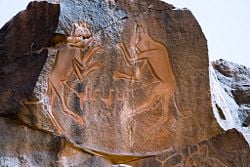
History
The word petroglyph comes from the Greek words petros meaning "stone" and glyphein meaning "to carve" (it was originally coined in French as pétroglyphe).[1]
The oldest petroglyphs are dated to approximately the Neolithic and late Upper Paleolithic boundary, about 10,000 to 12,000 years ago, if not earlier (Kamyana Mohyla).[2] Around 7,000 to 9,000 years ago, other precursors of writing systems, such as pictographs and ideograms, began to appear. Petroglyphs were still common though, and some cultures continued using them much longer, even until contact with Western culture was made in the twentieth century. Petroglyphs have been found in all parts of the globe except Antarctica with highest concentrations in parts of Africa, Scandinavia, Siberia, southwestern North America, and Australia.
Technique
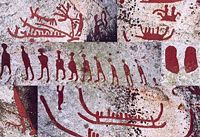
Petroglyphs are from removing rock in such ways as scratching, abrading, pecking, carving, drilling, incising, and sculpting. Locations of choice are rock facets coated with patina, a dark mineral accumulation on rock surfaces. Petroglyphs remove the patina, exposing the contrasting lighter rock interior. Instances of negative images, produced by removing the patina surrounding the intended figure, are also known. Sometimes petroglyphs are painted or accentuated by polishing. The degree of repatination indicates relative dating. Some of the most ancient petroglyphs are the same color as the surrounding rock.
Interpretation
There are many theories to explain their purpose, depending on their location, age, and the type of image. Some petroglyphs are thought to be astronomical markers, maps, and other forms of symbolic communication, including a form of "pre-writing." They might also have been a by-product of other rituals: sites in India, for example, have been identified as musical instruments or "rock gongs." [3]
Some petroglyph images probably had deep cultural and religious significance for the societies that created them; in many cases this significance remains for their descendants. Many petroglyphs are thought to represent some kind of not-yet-fully understood symbolic or ritual language. Later glyphs from the Nordic Bronze Age in Scandinavia seem to refer to some form of territorial boundary between tribes, in addition to possible religious meanings. It also appears that local or regional dialects from similar or neighboring peoples exist. The Siberian inscriptions almost look like some early form of runes, although there is not thought to be any relationship between them. They are not yet well understood.
Some researchers have noticed the resemblance of different styles of petroglyphs across different continents; while it is expected that all people would be inspired by their surroundings, it is harder to explain the common styles. This could be mere coincidence, an indication that certain groups of people migrated widely from some initial common area, or indication of a common origin.[4] Other theories suggest that petroglyphs were made by shamans in an altered state of consciousness[5], perhaps induced by the use of natural hallucinogens. Many of the geometric patterns (known as form constants) which recur in petroglyphs and cave paintings have been shown to be "hard-wired" into the human brain; they frequently occur in visual disturbances and hallucinations brought on by drugs, migraine, and other stimuli.
Petroglyph sites
Africa
There are many famous sights of petroglyph works in Africa. Tassili n'Ajjer in Algeria is noted for its prehistoric rock paintings and other ancient archaeological sites, dating from neolithic times when the local climate was much moister, with savannah rather than desert. The art depicts herds of cattle, large wild animals including crocodiles, and human activities such as hunting and dancing. The art has strong stylistic links to the pre-Nguni Art of South Africa and the region, executed in caves by the San Peoples before the year 1200 C.E.
Akakus, Libya was inscribed as a UNESCO World Heritage Site in 1985 because of the importance of its rock paintings and carvings. The art dates from 12,000 B.C.E. to 100 C.E. and reflect cultural and natural changes in the area.[6] There are paintings and carvings of animals such as giraffes, elephants, ostriches, and camels, but also of men and horses. Men are depicted in various daily life situations, for example while making music and dancing.
The ancient city of Wadi Hammamat in Qift, Egypt has many carvings and inscriptions dating from before the earliest Egyptian Dynasties to the modern era, including the only painted petroglyph known from the Eastern Desert and drawings of Egyptian reed boats dated to 4000 B.C.E.
Other important sites in Africa include Bidzar in Cameroon, Bambari, Lengo, and Bangassou in the south of the Central African Republic; Bwale in the west, Niola Doa in Chad, the Niari River valley in the Congo, Ogooue River Valley in Gabon, Jebel Uweinat in Libya, the Draa River valley in Morocco, the Twyfelfontein in Namibia, and life-size giraffe carvings on Dabous Rock, Air Mountains, in Niger.
Australia
Murujuga, in Western Australia is a unique ecological and archaeological area since it contains the world's largest and most important collection of petroglyphs – ancient Aboriginal rock carvings some claim to date back as far as the last ice age. The collection of standing stones is the largest in Australia. The rock art numbers over a million petroglyphs and contains many images of the now extinct Thylacine (Tasmanian Tiger).
The Sydney Rock Engravings consist of carefully drawn images of people, animals, and symbols, in the sandstone around Sydney, New South Wales, Australia. Many thousands of such engravings are known to exist in the Sydney region, although the locations of most are not publicized in order to prevent damage by vandalism, and to retain their sanctity, as they are still regarded as sacred sites by Indigenous Australians. They are comparable to petroglyphs of Native Americans, yet have their own distinctive style which is unlike rock art found anywhere else in Australia.
There is also a famous petroglyph site at Arnhem Land / Kakadu National Park, in Northern Australia.
Asia
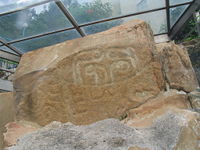
The diversity of Asia's geography and culture is mirrored in its quantity of petroglyphs. Hong Kong alone has eight significant sites: Tung Lung Island, Kau Sai Chau, Po Toi Island, Cheung Chau, Shek Pik on Lantau Island, Wong Chuk Hang and Big Wave Bay on Hong Kong Island, and Lung Ha Wan in Sai Kung
The Edakkal Caves in Wayanad, Kerala, in India date back to about 4000 B.C.E. These are not technically caves by rather a cleft or rift approximately 96 feet by 22 feet, a 30 foot deep fissure caused by a piece of rock splitting away from the main body. On one side of the cleft a rock weighing several tons has fallen over the fissure forming a roof. The carvings are of human and animal figures, as well as of tools used by humans and symbols, suggesting they were created by a highly civilized prehistoric people.[7] The petroglyphs inside the cave are of at least three distinct types. The oldest may date back over 5000 years ago. Evidence indicates that the Edakkal caves had been inhabited at several different times in history.[7]
The Bangudae Petroglyphs, in Korea are located in Daegok-ri, Ulsan, South Korea. This site of substantial engraved rock art was rediscovered in 1971 and was designated as the 285th National Treasure of South Korea on June 23, 1995. The petroglyphs sit in an isolated forested area almost completely enclosed by steep mountains adjacent to the Daegok-cheon River, a tributary of the Taehwa River. There are three major panels in an area measuring 3 m in height and 10 m in length. A number of panels with similar rock-art motifs have been found nearby at the Cheonjeon-ni site.
It is commonly thought that the petroglyphs (Kr. amgakhwa or bawi geurim, 바위그림) at this site depict the physical embodiment of the hopes and wishes of prehistoric people. In this case, the petroglyphs were made to wish for a successful hunt or an abundance of prey.
Other important sites include Chumysh River basin, in Khaszikstan, the Tamgaly on the Ili River, a World Heritage Site, the Yin Mountains in Inner Mongolia, the Rock art and petroglyphs in Northern Areas in Pakistan, and the Angono Petroglyphs of Rizal in the Philippines.
South America
There are two famous sites of petroglyphs in South America. Cumbe Mayo in Peru is the site of the ruins of a Pre-Columbian aqueduct stretching approximately five miles in length. There are a number of petroglyphs on the aqueduct and surrounding caverns.
The Corantijn Basin, one of a number of archaeological sites in Suriname, contains a large number of petroglyphs. An interesting aspect of these petroglyphs is that they are all found near water. Unfortunately, though, the majority of these petroglyphs cannot be connected to specific prehistoric indigenous groups.[8]
North America
North America has more petroglyph sites than any other continent. A large cluster is located in the Southwestern United States, and are protected by National Park boundaries, such as Arches National Park and Capitol Reef National Park of Utah, Death Valley National Park, Lava Beds National Monument, Tule Lake, Maturango Canyon, and Coso Range, Northern Mojave in California. There are also sites in Arkansas, Washington, Michigan, and Ohio.
The Jeffers Petroglyphs site is an outcrop of rock in southwestern Minnesota with pre-contact Native American petroglyphs. The petroglyphs are pecked into rock of the Red Rock Ridge, a 23-mile (37 km)-long Sioux quartzite outcrop that extends from Watonwan County, Minnesota to Brown County, Minnesota. The exposed surface is approximately 150 feet (50 m) by 650 feet (200 m) and surrounded by virgin prairie. Several old wagon trail ruts traverse the site, one of which is believed to be the old stage coach route from New Ulm, Minnesota to Sioux Falls, South Dakota.[9]
Petroglyph National Monument stretches 17 miles (27 km) along Albuquerque, New Mexico's West Mesa, a volcanic basalt escarpment that dominates the city’s western horizon. The 7,236 acre (29.28 km²) monument is cooperatively managed by the National Park Service and the City of Albuquerque. Petroglyph National Monument protects a variety of cultural and natural resources including five volcanic cones, hundreds of archaeological sites and an estimated 25,000 images carved by native peoples and early Spanish settlers. Many of the images are recognizable as animals, people, brands and crosses; others are more complex. Their meaning was, possibly, understood only by the carver. These images are the cultural heritage of a people who have long since moved into other areas and moved on through history. The monument protects them for visitors to see and appreciate for generations to come.
There are over 21,000 petroglyphs at the Three Rivers Petroglyph Site in Three Rivers, New Mexico, located midway between Tularosa and Carrizozo in Otero County.[10] Many of the petroglyphs can be easily viewed from a trail open to the public which winds through the rocks for about one mile. The petroglyphs are thought to be the product of the Jornada Mogollon people between about 1000 and 1400 C.E. The site is protected and maintained by the Bureau of Land Management. The exact age of the petroglyphs is not known, but some atlatl symbols at Jeffers are a close match with similar symbols at Indian Knoll in Kentucky, which have been dated to 3000 B.C.E. These are probably the earliest petroglyphs at the site and indicate that the site was first visited during the Late Archaic Period. Another clue to the age comes from the projectile point carvings, which show a projectile point design used by hunters in the Late Archaic Period. Other carvings, such as thunderbirds, dragonflies, turtles, and shamans, are symbolic of later tribes such as the Otoe tribe, Sioux, and Iowa tribe. These are believed to date between 900 C.E. and 1750 C.E.
There are several sites in Canada, in British Columbia, Ontario and Nova Scotia. Petroglyphs Provincial Park, is situated northeast of Peterborough, Ontario, Canada. It has the largest collection of ancient First Nations petroglyphs in Ontario. The carvings were created in the pre-Columbian era and represents aspects of First Nations mysticism, including shamans, animals, and the Great Spirit. The sacred stone is generally believed to have been carved by the Algonkian people between 900 and 1400 C.E. Today, the First Nations people of Ontario call the carvings Kinomagewapkong, meaning "the rocks that teach" or "the Teaching Rocks."
There are also petroglyph sites at Mina, Nuevo Leon in Mexico.
Europe
Like North America, Europe hosts a number of petroglyph sites. Mercantour National Park in France, Newgrange in Ireland, the Vale do Côa rock carvings of Portugal, the Tanumshede (Bohuslän) of Sweden (which is also a World Heritage Site) and Kamyana Mohyla in the Ukraine all have petroglyph sites.
The Cup and ring marked rocks in Northumberland, England are unique among petroglyphs. They consist of a concave depression, no more than a few centimeters across, pecked into a rock surface and often surrounded by concentric circles also etched into the stone. Sometimes a linear channel called a gutter leads out from the middle. Where they are etched onto natural, flat stone it has been observed that they seem to incorporate the natural surface of the rock. Those at Hunterheugh are mostly connected to one another by gutters that can channel rainwater from one to the next, down the sloping top of the stone.
The site of Val Camonica, Italy is home to the greatest complex of rock drawings in sub-Alpine Italy, with approximately 350,000 petroglyphs drawn by members of the Camunni tribe on hundreds of exposed rocks dating from about 8000 B.C.E.; cosmological, figurative, and cartographic motifs are featured, in some locations forming monumental hunting and ritual "scenes." It includes also scenes of zoophilia.
The Rock carvings at Alta in Norway are located now at a World Heritage Site. Since the first petroglyphs were discovered in 1972, more than 5000 carvings have been found on several sites around Alta. The main site, located at Jiepmaluokta about 4 kilometers outside of Alta, contains around 3000 individual carvings and has been turned into an open-air museum. It is Norway's only prehistoric World Heritage Site. The earliest carvings in the area date to around 4200 B.C.E.; the most recent carvings are generally dated to around 500 B.C.E. The wide variety of imagery shows a culture of hunter-gatherers that was able to control herds of reindeer, was adept at boat building and fishing and practiced shamanistic rituals involving bear worship and other venerated animals. Apart from the visual evidence of the carvings themselves, not much is known about the culture that produced these carvings.
Middle East
There are petroglyph sites in the Wadi Rum and Wadi Faynan of Jordan, made by many human cultures since prehistoric times, with many cultures—including the Nabateans—all of whom left their mark in the form of rock paintings, graffiti, and temples. The "Graffiti Rocks," about 110 km SW of Riyadh off the Mecca highway is another important petroglyph site in the Middle East.
Notes
- ↑ Douglas Harper, "Petroglyph", Online Etymology Dictionary. Retrieved December 11, 2007.
- ↑ Albert B. Scholl, Jr., Rock Art and Ruins for Beginners and Old Guys (Rainbow Publishing Services, 2001).
- ↑ Ancient Indians made 'rock music', BBC News Friday, 19 March, 2004. Retrieved December 19, 2007.
- ↑ Stan Beckensall, Northumberlands Prehistoric Rock Carvings: Mystery Explained, (Pendulum Press 1983 ISBN 0950693537)
- ↑ Ekaterina Devlet, Rock Art and the Material Culture of Siberian and Central Asian Shamanism in The Archaeology of Shamanism, ed. Neil Price 43-55 (London: Routledge, 2001). Retrieved December 19, 2007.
- ↑ UNESCO World Heritage Centre "Rock-Art Sites of Tadrart Acacus" Retrieved December 13, 2007.
- ↑ 7.0 7.1 Kerala.gov "Places of Tourist Importance" 2007.
- ↑ A.H. Versteeg, "The history of archaeological research in Suriname." Retrieved July 28, 2011.
- ↑ Cottonwood County Historical Society, Centennial History of Cottonwood County, Minnesota. (Cottonwood County Historical Society, 1970).
- ↑ Jim Reed, Three Rivers Petroglyphs Site—21,000 Carvings SouthernNewMexico.com. Wednesday, July 16, 2003. Retrieved December 13, 2007.
ReferencesISBN links support NWE through referral fees
- Beckensall, Stan. Prehistoric Rock Art in Northumberland. Tempus Publishing, 2001. ISBN 0752419455
- Beckensall, Stan, and Tim Laurie. Prehistoric Rock Art of County Durham, Swaledale and Wensleydale. County Durham Books, 1998. ISBN 1897585454
- Cottonwood County Historical Society. Centennial History of Cottonwood County, Minnesota. Cottonwood County Historical Society, 1970. ASIN B000LPUQ9Y
- de Jonge, R.M., and J.S. Wakefield. Discovery of the Islands in the Ocean, 2011. Retrieved July 2, 2011.
- Keyser, James D. Indian Rock Art of the Columbia Plateau. University of Washington Press, 1992. ISBN 978-0295971605
- Morris, Ronald. The Prehistoric Rock Art of Galloway and The Isle of Man. Blandford Press 1979. ISBN 978-0713709742
- Price, Neil. The Archaeology of Shamanism. London: Routledge, 2001. ISBN 978-0415252553
- Scholl, Albert B., Jr. Rock Art and Ruins for Beginners and Old Guys. Rainbow Publishing Services, 2001. ISBN 0970468806
- Versteeg, A.H. "The history of archaeological research in Suriname." In Th.E. Wong, D.R. de Vletter, L. Krook, J.I.S. Zonneveld, and A.J. van Loon (eds.), The History of Earth Sciences in Suriname (Kon. Ned. Academie Wetenschappen & Nederlands Instituut voor Toegepaste Geowetenschappen TNO, (1998): 203-234). Retrieved July 28, 2011.
Gallery
Engravers from Val Camonica, Italy
Rock Carving in Tanum, Sweden
Carving "The Shoemaker," Brastad, Sweden
Petroglyphs at Orongo, Rapa Nui (Easter Island). A Make-make at the base and two birdmen higher up
External links
All links retrieved November 23, 2022.
- Petroglyph Provincial Park
- Sarmish-Say, The Bronze Age Art Gallery - Petroglyphs
- Bradshaw Foundation
- Giraffe carvings on Dabous Rock, Air Mountains, Niger Bradshaw Foundation
- Rock Art of Western Central Africa Bradshaw Foundation
- Rock Art Research Institute (RARI) University of the Witwatersrand Bradshaw Foundation
- Rock Art Research Institute website (Witwatersrand)
- Latin American rock art articles and rock art researchers directory ARTE RUPESTRE (in Spanish)
- Dolmenes y megalitos del mundo
- Menhires del mundo
| |||||||||||||||||||||||||||||||||||
Credits
New World Encyclopedia writers and editors rewrote and completed the Wikipedia article in accordance with New World Encyclopedia standards. This article abides by terms of the Creative Commons CC-by-sa 3.0 License (CC-by-sa), which may be used and disseminated with proper attribution. Credit is due under the terms of this license that can reference both the New World Encyclopedia contributors and the selfless volunteer contributors of the Wikimedia Foundation. To cite this article click here for a list of acceptable citing formats.The history of earlier contributions by wikipedians is accessible to researchers here:
The history of this article since it was imported to New World Encyclopedia:
Note: Some restrictions may apply to use of individual images which are separately licensed.
